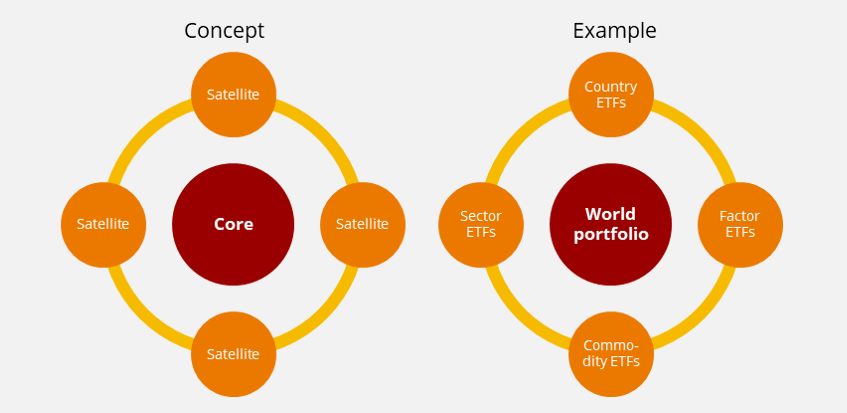How to implement the Core-Satellite strategy with ETFs
The Core-Satellite strategy boosts a Buy and Hold portfolio with exotic ‘satellite’ asset classes that have the potential to enhance risk-adjusted returns

- Level: Advanced
- Reading duration: 5 minutes
What to expect
What is Core-Satellite?
Core-Satellite investing is a best-of-both-worlds strategy that aims to increase performance and diversification while keeping costs and volatility low. The strategy is founded on two complementary components: the core and the satellites. Visually the strategy looks like a planet surrounded by its moons. The core holding is a classic Buy and Hold combination such as a World Equities ETF and a domestic Government Bond ETF. This ensures that the bulk of your portfolio is broadly diversified in low cost, low correlation asset classes that can be weighted to suit your risk appetite. The satellites are specialised ETFs that enable you to diversify further into markets that promise higher risk-adjusted returns, or are uncorrelated with the core, or perform well under difficult market conditions, or some part of all three of those Holy Grail virtues. See Suitable Satellite ETFs below. The Core-Satellite strategy was developed by two American economists, Fischer Black and Jack Treynor. They were spurred into action by the Efficient Market Hypothesis (EMH) devised by Eugene Fama. This theory proposes all information about a publicly traded security is already incorporated into its price in an efficient market. For example, there’s no point selling oil and gas equities in an efficient market to avoid the impact of decarbonisation. If EMH is correct then the price of those equities has already adjusted to account for that public knowledge. EMH advocates, therefore, believe it’s impossible to beat the market (unless you take more risk) and so reject active management. Yet Black and Treynor found that some equities can generate excess returns, an insight that led to the Core-Satellite strategy. The core part of the portfolio reflects the fact that the biggest, broadest markets are mostly efficient and extremely hard to beat. But the satellite allocation enables investors to exploit less efficient markets and to act when sentiment forces prices away from fair value over short to medium time horizons. While Core-Satellite investing theoretically enabled investors to mine the exceptions that prove the EMH rule, it was exceptionally difficult to execute the strategy when Black and Treynor invented it in the 1970s. However, all that changed with the emergence of ETFs that provide liquid, low-cost exposure to niche markets.Structuring a Core-Satellite ETF portfolio
80% core and 20% satellites is a common rule of thumb. The core is invested on a Buy and Hold basis for the long-term. Using a World Equities ETF and a Gilt ETF (or Global Bond ETF hedged to € or £) is an excellent low-cost core that maximises diversification, reduces volatility and is easy to rebalance.
Source: justETF
The role of the satellites is to complement the core with shorter-term holdings that offer the potential for higher investment returns or even greater diversification via non-correlated asset classes.
Black and Treynor used historical data to justify weighting the satellite section towards assets with the highest return potential. But it’s just as rational to equally weight your satellites given that past performance is no guarantee of future return.
Suitable satellite ETFs
The success of your Core-Satellite strategy versus a simple Buy and Hold portfolio rests squarely on your satellite selections. The following ETF categories are good hunting grounds:- Sector ETFs
- Country ETFs
- Emerging markets ETFs
- Frontier markets ETFs
- Factor ETFs
- Precious metal ETCs
- Commodity ETFs
- Money market ETFs in foreign currency
- High yield bond ETFs
- Inflation-linked bond ETFs (Gilts or global hedged to € or the £)
- Gold has historically performed well in economic circumstances that have hurt equities and bonds and has traditionally been uncorrelated with both.
- Inflation-linked bonds can be expected to perform well in high inflation scenarios.
- Factor ETFs tilt towards equities with market-beating expected returns.
- Emerging and Frontier market ETFs provide exposure to fast-growing economies.
A market assessment is required
Your satellite allocation depends on your:- Strategic market assessment
- Market timing tactics
Testing the Core-Satellite portfolio
Developing and testing your Core-Satellite portfolio is considerably more time-consuming than Buy and Hold. Ideally, you’ll develop systematic rules for satellite investing and then test your assumptions using historical data. For example, you may discover that certain macroeconomic indicators are historically correlated with a particular country index outperforming the MSCI World index. Positive indicators act as a buying signal and negative indicators act as a selling signal. This is a systematic rule, if it’s historically replicable using market data, and saves you from relying on your gut instinct. Alternatively, you could use historical data to assess the ability of certain asset classes to protect your portfolio in harsh market conditions. For example, are energy equities really a good inflation hedge? The longer your sample period, the better your data, the greater your expertise, the more confident you can be in your theory. However, no amount of data points can forecast the future, so you must always be prepared for the possibility that your satellites will not outperform. That’s why it’s important to maintain a strong and steady core allocation that is underpinned by diversification and a long-term investing approach.Do not lose sight of risks
If all that sounds daunting, then good. While trend-spotting and market-timing can be very profitable, it takes considerable knowledge, skill and nerve to be consistently successful. That’s what makes the Core-Satellite strategy so interesting. It enables you to test your ability without taking excessive risks in niche sectors. By avoiding over-concentration, you are more likely to be able to handle your most volatile satellites. It’s important to remember that diversification relies on non-correlated volatility and if you keep a close eye on your assets then you can exploit price swings to buy low and sell high. Enforce this discipline by rebalancing across your satellite and core holdings when your asset allocation thresholds are breached.Costs can quickly erode your returns
Low OCF ETFs keep costs in check but racking up dealing fees can still eat away your return. The best solution is to limit the number of ETFs in your portfolio and to avoid trading too much. You can easily get away with a core holding of two ETFs: one equity and one bond. Meanwhile, three or four ETFs should be ample for your satellites. But will the Core-Satellite strategy suit your style? Yes, if you are an engaged investor who likes to express their market views through their portfolio and wants a shot at the win-win-win of greater diversification, low costs and the potential for higher risk-adjusted returns.Core-Satellite pros and cons at a glance
| Criteria | Rating | Rationale |
|---|---|---|
| One-time effort | High | Picking core and satellites, choosing allocation |
| Ongoing effort | Medium | Rebalancing core and satellites |
| Turnover | Medium | Tactical use of satellites |
| Market opinion/research | Required | Short to medium-term satellite plays |
| Holding period | Medium | Aims for medium-term investment success |
| Easily customisable | Simple | Spread bets, avoid over-concentration |
| Backtesting | Costly | Difficult, susceptible to data-mining |









